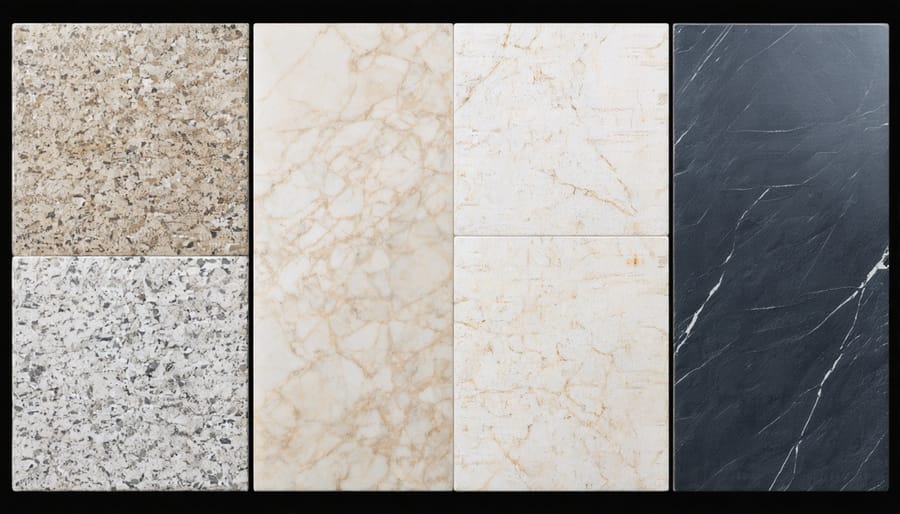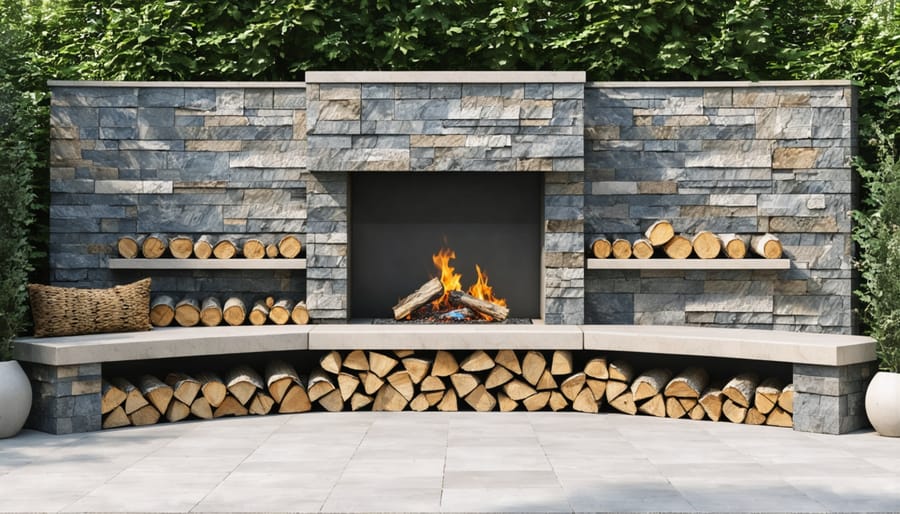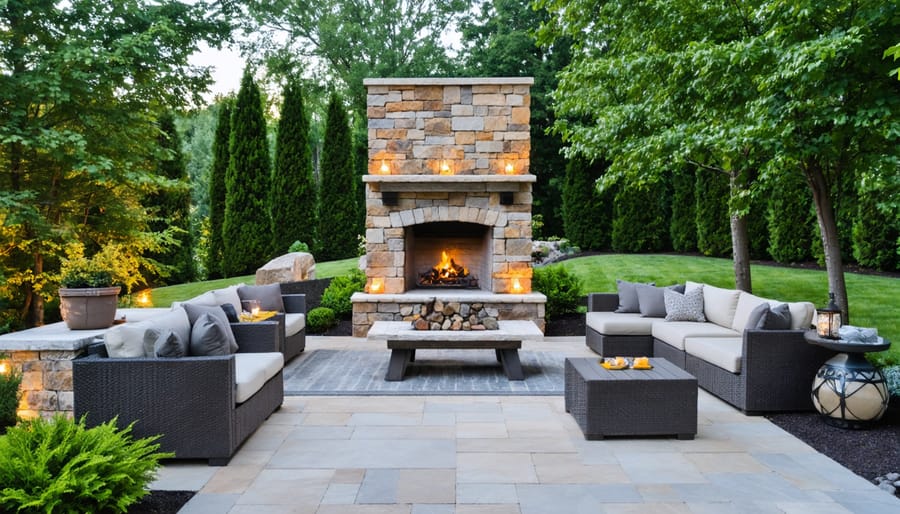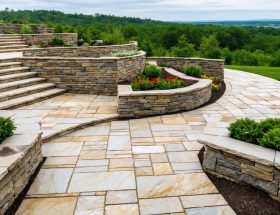Transform your outdoor living space into a stunning year-round retreat with a meticulously designed stone fireplace that will transform your home’s value and create an unforgettable gathering spot. Natural stone fireplaces merge timeless elegance with rugged durability, offering unmatched design versatility for any architectural style or landscape setting.
From rustic fieldstone hearths that complement wooded landscapes to sleek limestone surrounds that enhance modern patios, outdoor stone fireplaces serve as both functional heating elements and dramatic focal points. The enduring appeal of materials like granite, limestone, and quartzite ensures your investment maintains its beauty while withstanding harsh weather conditions.
Beyond aesthetic appeal, these architectural features extend your living space, creating an intimate atmosphere for entertainment and relaxation throughout multiple seasons. Whether integrated into an existing outdoor kitchen, positioned as a standalone feature, or incorporated into a covered pavilion, stone fireplaces offer unlimited design possibilities while providing practical warmth and ambiance for years to come.
Classic Stone Fireplace Styles
Rustic Fieldstone Designs
Rustic fieldstone designs capture the untamed beauty of nature, featuring irregular stones of varying sizes and shapes carefully arranged to create a deliberately imperfect appearance. This traditional building technique showcases stones in their most natural state, with rough-hewn surfaces and organic color variations that range from earthy browns to cool grays.
The beauty of fieldstone lies in its authentic, weathered appearance and the skilled craftsmanship required to fit these irregular pieces together. Each stone is hand-selected and positioned to ensure structural integrity while maintaining the fireplace’s rustic character. The mortar joints are often recessed or brushed to emphasize the stones’ natural contours, creating deeper shadows and more visual interest.
Popular fieldstone patterns include mosaic-style arrangements, where smaller stones fill gaps between larger pieces, and coursed patterns that maintain somewhat consistent horizontal lines while preserving the stones’ natural shapes. These designs often incorporate larger cornerstone pieces and striking hearth stones, adding architectural weight to the structure while reinforcing its connection to the surrounding landscape.
For enhanced authenticity, many designers incorporate local stone varieties, ensuring the fireplace appears as if it emerged naturally from the property itself.

Traditional Stacked Stone
Traditional stacked stone fireplaces showcase meticulous craftsmanship through precisely cut and carefully arranged stones, creating a timeless elegance that elevates any outdoor living space. This classic design approach features uniform stones laid in horizontal courses, establishing clean lines and a structured appearance that appeals to those seeking a refined aesthetic.
The beauty of traditional stacked stone lies in its deliberate uniformity, where each stone is specifically selected and placed to maintain consistent height within each row. This methodical arrangement creates a sophisticated pattern that draws the eye upward, making the fireplace appear taller and more commanding. Natural variations in stone coloring add subtle depth while maintaining the overall ordered appearance.
Popular stone choices for this style include limestone, granite, and cut fieldstone, each offering distinct textural characteristics while maintaining the precise, geometric layout. The organized pattern not only delivers visual appeal but also ensures structural integrity and easier maintenance over time. When paired with a detailed mantel and hearth, traditional stacked stone fireplaces become elegant focal points that anchor outdoor entertainment areas with enduring sophistication.
Material Selection Guide
Natural Stone Options
When selecting materials for your outdoor fireplace, various natural stone finishes offer distinct characteristics that can enhance your outdoor living space. Granite stands out for its exceptional durability and resistance to weather extremes, making it ideal for regions with harsh climates. Available in a wide spectrum of colors and patterns, granite maintains its appearance with minimal maintenance.
Limestone brings a timeless elegance with its warm, earthy tones and natural variations. While softer than granite, properly sealed limestone proves remarkably durable for outdoor applications. Its consistent coloring and texture create a sophisticated look that ages gracefully over time.
Slate offers excellent heat resistance and striking visual appeal with its distinctive layered appearance. Available in deep grays, blues, and earth tones, slate can be split into thin layers for a more rustic aesthetic or honed smooth for a contemporary look.
Other notable options include quartzite, known for its crystalline sparkle and granite-like durability, and travertine, which offers a Mediterranean feel with its natural pitting and warm color palette. Each stone type can be customized through different finishing techniques to achieve your desired aesthetic while maintaining the material’s natural character and structural integrity.

Durability and Weather Resistance
When selecting stone for your outdoor fireplace, durability and weather resistance are crucial factors that determine long-term performance. Natural stones like granite and quartzite excel in outdoor settings due to their exceptional resistance to freeze-thaw cycles and minimal water absorption rates. These materials maintain their structural integrity and appearance even after years of exposure to harsh weather conditions.
Limestone and sandstone, while beautiful choices, require more maintenance in regions with frequent rainfall or severe temperature fluctuations. These sedimentary rocks may benefit from periodic sealing to prevent moisture penetration and potential deterioration. Bluestone, a popular choice for outdoor fireplaces, offers excellent durability and naturally resists temperature extremes, making it ideal for fireplace surrounds and hearths.
Consider your local climate when selecting stone materials. In coastal areas, salt-resistant stones like granite and slate prove more resilient against salt air exposure. For regions with intense sun exposure, lighter-colored stones not only resist fading but also remain cooler to the touch compared to darker varieties.
Professional installation techniques, including proper moisture barriers and appropriate mortar selection, significantly impact weather resistance. Regular maintenance, such as annual inspections and prompt repairs of any cracks or loose joints, helps ensure your outdoor stone fireplace remains both beautiful and functional throughout the seasons.
Design Features and Add-ons

Built-in Seating Options
Integrating built-in seating around your outdoor stone fireplace creates a natural gathering space and maximizes the functionality of your outdoor living area. Stone benches can be constructed using the same materials as your fireplace, creating a cohesive look while providing permanent, weather-resistant seating options.
Consider incorporating L-shaped stone benches that wrap around the fireplace, offering multiple viewing angles and comfortable seating for larger groups. These can be topped with weather-resistant cushions in complementary colors to enhance comfort while maintaining the natural aesthetic. For a more rustic approach, large boulder seats or carved stone blocks can serve as organic seating elements that blend seamlessly with the landscape.
Built-in stone seat walls offer additional benefits beyond seating. They can define the space, act as retaining walls for elevated areas, and provide extra surface area for decorative elements or drink placement. Consider adding stone caps with a slight overhang for comfort and incorporating backup lighting underneath for ambiance.
For maximum versatility, design floating stone benches with space underneath for firewood storage. Include varying seat heights to accommodate different groups and activities, and consider adding curved sections to soften the overall appearance and encourage conversation. Remember to maintain proper distance between seating and the fireplace for safety while ensuring guests can enjoy the warmth comfortably.
Storage and Cooking Features
A well-designed outdoor stone fireplace can incorporate practical storage and cooking features that enhance its functionality. Built-in wood storage compartments, strategically placed at either side of the fireplace, provide convenient access to fuel while creating an attractive architectural element. Consider incorporating weather-resistant doors or covers to protect your firewood from the elements.
For cooking enthusiasts, adding a stainless steel cooking grate or adjustable grilling surface transforms your fireplace into a versatile outdoor kitchen feature. Custom-built stone countertops adjacent to the fireplace offer valuable prep space and serving areas. Many homeowners opt to include a built-in pizza oven, which can be integrated above the main firebox or as a separate compartment within the stone structure.
Popular cooking additions include swing-arm grills, rotisserie attachments, and Dutch oven hooks. Stone ledges at comfortable working heights provide space for cooking tools and serving platters. For added convenience, consider building storage cabinets beneath these surfaces for outdoor dining essentials and grilling equipment.
When planning storage and cooking features, ensure proper ventilation and heat management. Use heat-resistant materials for cooking surfaces and maintain appropriate clearances between hot zones and wooden storage areas. Including a dedicated ash dump and clean-out door simplifies maintenance and ensures safe operation of both the fireplace and cooking features.
Installation and Maintenance Considerations
Foundation Requirements
A solid foundation is crucial for any outdoor stone fireplace, as it must support significant weight and withstand environmental factors. The base typically requires a concrete pad at least 6 inches thick, with proper reinforcement using steel rebar. For larger fireplaces, the foundation depth may need to increase to 8-12 inches, depending on local building codes and soil conditions.
Before pouring the concrete, ensure proper site preparation by removing all organic material and compacting the soil. The foundation should extend at least 12 inches beyond the fireplace footprint on all sides and be perfectly level. In freeze-prone regions, the footing must extend below the frost line to prevent shifting during seasonal changes.
For optimal drainage, incorporate a slight slope (about 1/8 inch per foot) away from the structure and install a gravel base beneath the concrete pad. This helps prevent water accumulation and potential foundation damage. Following expert stone installation tips ensures your fireplace remains stable for decades.
The foundation must also account for any additional features like hearths, seating walls, or wood storage areas. Consider installing conduit for electrical or gas lines during the foundation phase if you plan to include lighting or gas ignition systems.
Safety Considerations
Safety should be your top priority when planning and installing an outdoor stone fireplace. Maintain a minimum clearance of 10 feet from any structures, trees, or combustible materials. The chimney height should extend at least 2 feet above nearby rooflines to ensure proper draft and prevent smoke from entering living spaces.
Proper ventilation is crucial for safe operation. Your fireplace must have adequate airflow, achieved through correct chimney sizing and design. The smoke chamber should be appropriately angled to direct smoke upward efficiently. Install a chimney cap to prevent debris and animals from entering while protecting against downdrafts.
Always check local building codes and obtain necessary permits before construction. Many jurisdictions have specific requirements regarding fireplace placement, height restrictions, and fire-resistant materials. Some areas may require professional installation or regular safety inspections.
Consider installing spark arrestors and using appropriate screening to contain embers. Place a fire extinguisher nearby and ensure proper drainage around the fireplace base to prevent water accumulation. Regular maintenance, including annual chimney cleaning and inspection of mortar joints, will help ensure continued safe operation.
Seasonal Maintenance Tips
To maintain your stone fireplace throughout the year, follow a seasonal maintenance schedule. In spring, inspect for winter damage and clean the chimney. Remove any plant debris, check for loose mortar, and apply a fresh coat of sealant if needed. During summer, keep the firebox clean and protect the hearth from excessive sun exposure with appropriate covering when not in use.
Fall maintenance is crucial before heavy use begins. Clean the chimney again, check the cap and screen for damage, and ensure proper drainage around the structure. Consider applying a weather-resistant cover during severe weather events. In winter, remove snow and ice promptly to prevent moisture damage, and avoid using harsh de-icing chemicals near the stone.
Year-round, address any signs of deterioration immediately, keep the surrounding area clear of vegetation, and use appropriate cleaning products specifically designed for natural stone. Regular inspections and prompt repairs will significantly extend your outdoor fireplace’s lifespan and maintain its aesthetic appeal.
An outdoor stone fireplace is more than just a beautiful addition to your backyard – it’s an investment in creating lasting memories and enhancing your home’s value. Throughout this guide, we’ve explored various design options, from rustic natural stone styles to elegant contemporary layouts, each offering unique possibilities for your outdoor space.
Remember that successful implementation starts with careful planning. Consider your space requirements, local building codes, and climate conditions when selecting materials and design features. Natural stone remains an exceptional choice for outdoor fireplaces, offering durability, weather resistance, and timeless appeal that synthetic materials simply can’t match.
Whether you choose a dramatic floor-to-ceiling fireplace, a cozy corner installation, or a multi-functional cooking hearth, ensure your design complements your home’s architecture and landscape. Don’t forget practical elements like proper ventilation, adequate seating areas, and convenient wood storage.
Now is the perfect time to transform your outdoor living space with a stone fireplace. Start by gathering inspiration from the styles we’ve discussed, consult with local professionals, and create a detailed plan that addresses both aesthetic and functional requirements. With proper planning and execution, your outdoor stone fireplace will become the centerpiece of countless gatherings and peaceful evenings under the stars for years to come.










